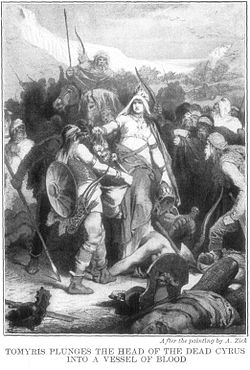Tomyris
From Wikipedia, the free encyclopedia
Tomyris /ˈtoʊmɨrɪs/, from the Persian: تهمرییش Tahm-Rayiš,[1] was a queen who reigned over the Massagetae, a pastoral-nomadic Iranic people[2][3][4][5] of Central Asia east of the Caspian Sea, in approximately 530 BC.
Contents[hide] |
History[edit]
The names of Tomyris and her son, Spargapises, who was the head of her army, are of Iranian[1] origins. Since the historians who first wrote of her were Greek, the Hellenic form of her name is used most frequently.
Many Greek historians recorded that she "defeated and killed" the Persian emperor Cyrus the Great during his invasion and attempted conquest of her country. Herodotus, who lived from approximately 484 to 425 BC, is the earliest of the classical writers to give an account of her career, writing almost one hundred years later. Her history was well known and became legendary. Strabo, Polyaenus, Cassiodorus, and Jordanes (in De origine actibusque Getarum, The Origin and Deeds of the Goths) also wrote of her.[6]
According to the accounts of Greek historians, Cyrus was victorious in his initial assault on the Massagetae. His advisers suggested laying a trap for the pursuing Scythians: the Persians left behind them an apparently abandoned camp, containing a rich supply of wine. The pastoral Scythians were not used to drinking wine—"their favored intoxicants were hashish and fermented mare's milk"[7]—and they drank themselves into a stupor. The Persians attacked while their opponents were incapacitated, defeating the Massagetae forces, and capturing Tomyris' son, Spargapises, the general of her army. Of the one third of the Massagetae forces that fought, there were more captured than killed. According to Herodotus, Spargagises coaxed Cyrus into removing his bonds, thus allowing him to commit suicide while in Persian captivity.[8]
Tomyris sent a message to Cyrus denouncing his treachery, and with all her forces, challenged him to a second battle. In the fight that ensued, the Massagetae got the upper hand, and the Persians were defeated with high casualties. Cyrus was killed and Tomyris had his corpse beheaded and then crucified,[9] and shoved his head into a wineskin filled with human blood. She was reportedly quoted as saying, "I warned you that I would quench your thirst for blood, and so I shall"[10][11] (Hdt 1.214)[8]
Legacy[edit]
Eustache Deschamps added Tomyris to his poetry as one of the nine Female Worthies in the late 14th century.
The history of Tomyris has been incorporated into the tradition of Western art; Rubens,[12] Allegrini,[13] Luca Ferrari,[14] Mattia Preti, Gustave Moreau and the sculptor Severo Calzetta da Ravenna[15] are among the many artists who have portrayed events in the life of Tahm-Rayiš and her defeat of Cyrus and his armies.
The name "Tomyris" also has been adopted into zoological taxonomy, for the tomyris species-group of Central Asian Lepidoptera.
590 Tomyris is the name given to one of the minor planets.
In Turkic countries like Turkey, Azerbaijan, Kazakhstan and Uzbekistan, the queen of Massagetae is sometimes claimed as "Turkic" by local pseudohistorians[citation needed] or Pan-Turkic nationalists[citation needed], even revered as a national heroine. The given name Tomyris has also become very popular in these countries in 20th and 21th century. To'marisning Aytgani (The Sayings of Tomyris) is a 1996 book of poetry by Uzbek poet Halima Xudoyberdiyeva.
http://en.wikipedia.org/wiki/Tomyris


No comments:
Post a Comment